Indoor water gardens are a fantastic way to bring a little nature indoors while creating a calm and refreshing space. These mini ecosystems can be as simple or elaborate as you like, featuring everything from colorful fish to beautiful aquatic plants. Perfect for any room, they add a unique touch and a serene vibe, making it easy to unwind and enjoy the beauty of water right at home.
Choosing the Right Container for Your Water Garden
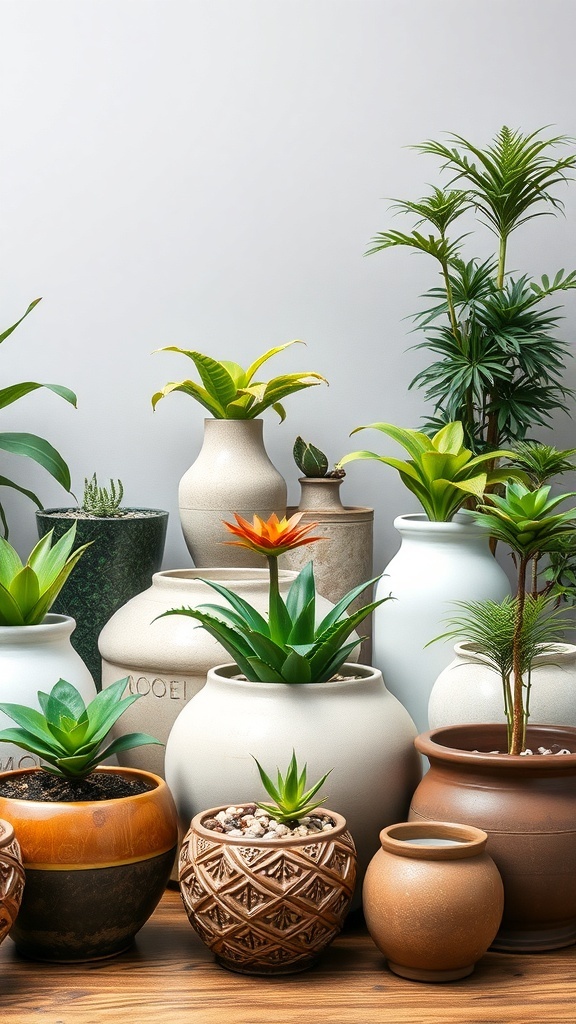
Creating an indoor water garden is a fun way to bring nature into your home. One of the first steps is choosing the right container. The image shows a variety of pots and planters, each with unique shapes and sizes. This variety can inspire your own selection.
When picking a container, think about the size of your space. Larger pots can hold more water and plants, while smaller ones are perfect for tight areas. The materials also matter. Clay, ceramic, and plastic each have their pros and cons. Clay pots are beautiful but can be heavy, while plastic is lightweight and easy to move.
Drainage is key for any water garden. Make sure your container has holes to prevent overwatering. If you find a pot you love without drainage, you can always use it as a decorative outer pot and place a smaller, drilled pot inside.
Lastly, consider how the container fits into your home’s style. Whether you prefer modern, rustic, or something in between, there’s a pot that will match your vibe. So, take your time and choose a container that not only works for your plants but also looks great in your space.
Incorporating Fish into Your Water Garden
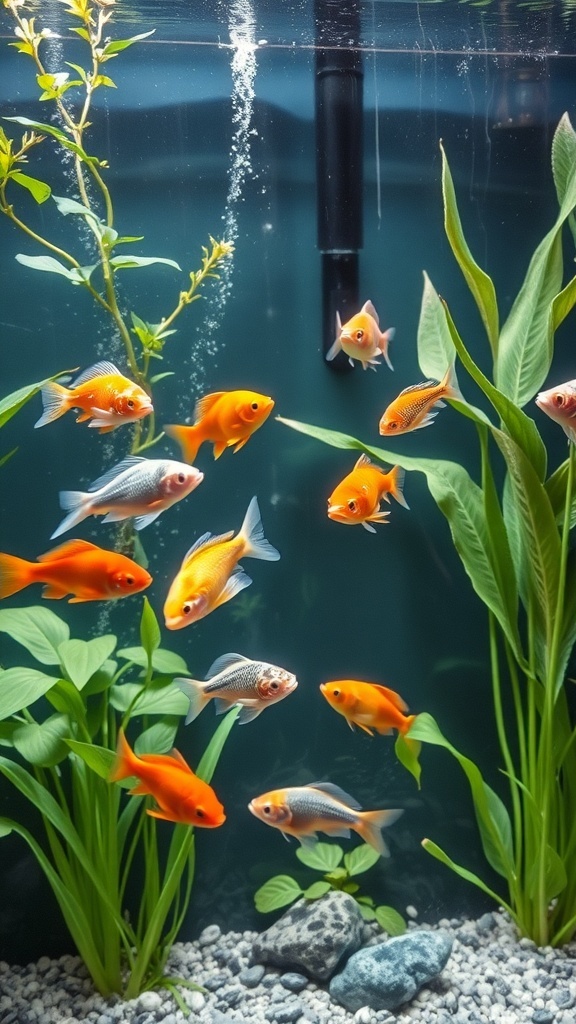
Adding fish to your indoor water garden can bring it to life. The vibrant colors and playful movements of fish create a lively atmosphere. In the image, you can see a variety of fish swimming among lush green plants. This combination not only looks beautiful but also helps maintain a balanced ecosystem.
When choosing fish, consider species that thrive in smaller environments. Goldfish and guppies are popular options. They are hardy and adapt well to indoor settings. Make sure to provide enough space and clean water for them to thrive.
Plants play a crucial role in your water garden. They offer hiding spots for fish and help keep the water clean. The plants in the image contribute to a healthy environment, making it a perfect home for the fish.
Regular maintenance is key. Check water quality and feed your fish properly. Observing their behavior can be a delightful experience. Watching them swim and interact with their surroundings adds joy to your indoor space.
Lighting Solutions for Indoor Water Gardens
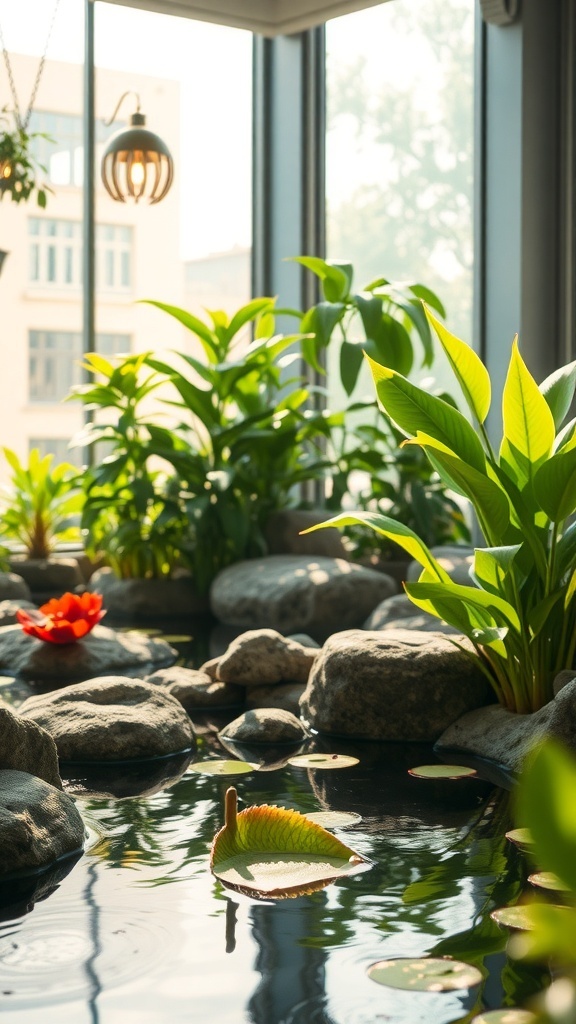
Creating a stunning indoor water garden is not just about the plants and water features. The right lighting can make all the difference. In the image, you can see a beautiful setup with natural light pouring in through large windows. This kind of light is perfect for plants, helping them thrive while also enhancing the overall look of the garden.
Consider adding pendant lights or spotlights to highlight specific areas. The warm glow from the hanging light in the image adds a cozy feel, making the space inviting. You can use LED lights to create different moods, whether you want a bright, cheerful atmosphere or a soft, relaxing vibe.
Another option is to use underwater lights. These can illuminate the water, making it shimmer and sparkle. This effect can create a magical ambiance, especially in the evenings. Just be sure to choose lights that are safe for aquatic environments.
Finally, think about the placement of your lights. Positioning them to cast shadows can add depth and interest to your garden. Experiment with different angles to find what works best for your space.
Creating a Balanced Ecosystem
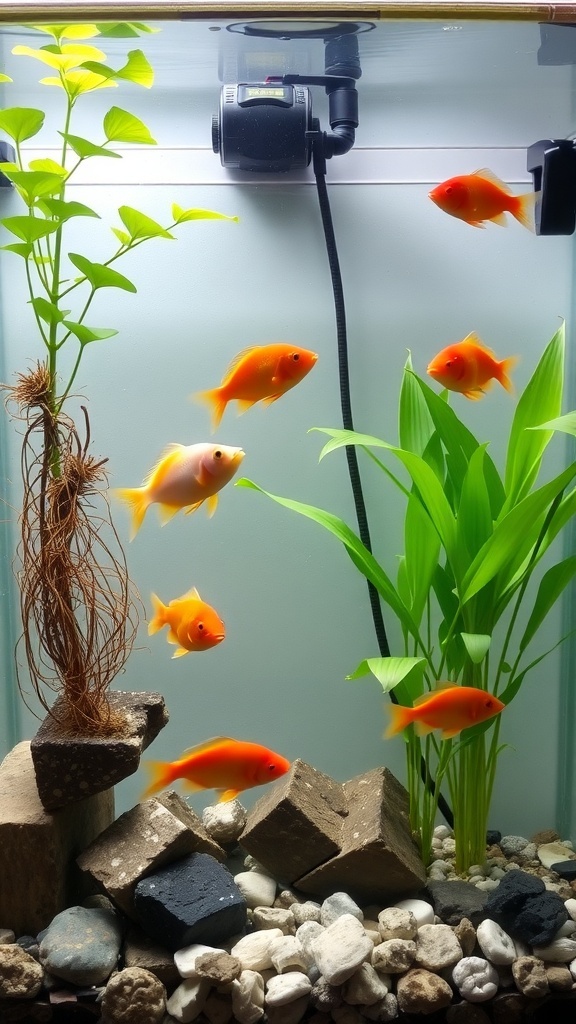
Setting up an indoor water garden is a fun way to bring nature into your home. The image shows a beautifully arranged fishbowl with vibrant plants and lively goldfish. This setup not only looks great but also creates a balanced ecosystem.
In this ecosystem, fish and plants work together. The fish provide nutrients for the plants through their waste, while the plants help clean the water. This natural cycle keeps everything healthy and thriving.
Choosing the right plants is key. In the image, you can see a variety of greenery that adds life to the bowl. Plants like water lilies and ferns are perfect for this type of environment. They not only look good but also help maintain water quality.
Lighting is another important factor. The image features a light that supports plant growth. Proper lighting ensures that the plants can photosynthesize, which is essential for their health and the overall balance of the ecosystem.
Regular maintenance is necessary too. This includes checking water levels and cleaning the bowl. Keeping an eye on the fish and plants helps you catch any issues early, ensuring your indoor water garden stays vibrant and lively.
Setting Up the Water Quality
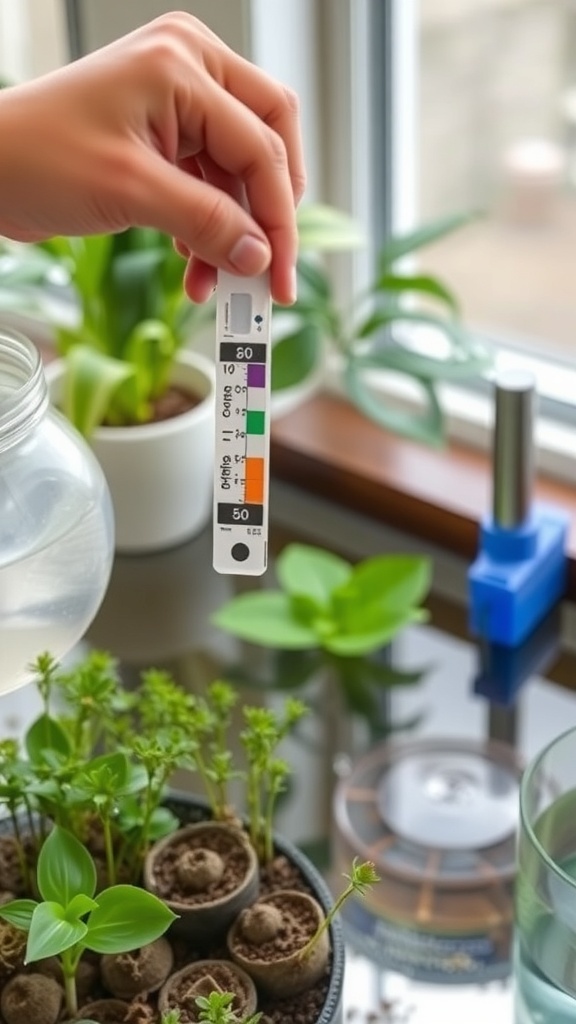
Creating an indoor water garden is a fun way to bring nature into your home. One key aspect to focus on is water quality. The image shows someone checking the water quality with a test strip, which is essential for keeping plants and any aquatic life healthy.
First, you need to test the water for pH levels. Most aquatic plants thrive in slightly acidic to neutral water, usually between 6.0 and 7.5. If the pH is too high or too low, you can adjust it using pH up or down solutions available at garden centers.
Next, check for ammonia and nitrite levels. These can be harmful to your plants and fish. Ideally, both should be at zero. If you find any readings, consider using a water conditioner to neutralize these substances.
Don’t forget about nitrate levels too. While some nitrates are okay, high levels can lead to algae growth. Regular water changes help keep these levels in check. Aim for a 10-20% water change every week to maintain a healthy environment.
Lastly, consider adding a water filter. This helps keep the water clean and clear, making your indoor water garden a beautiful focal point in your space.
Selecting Aquatic Plants for Your Space
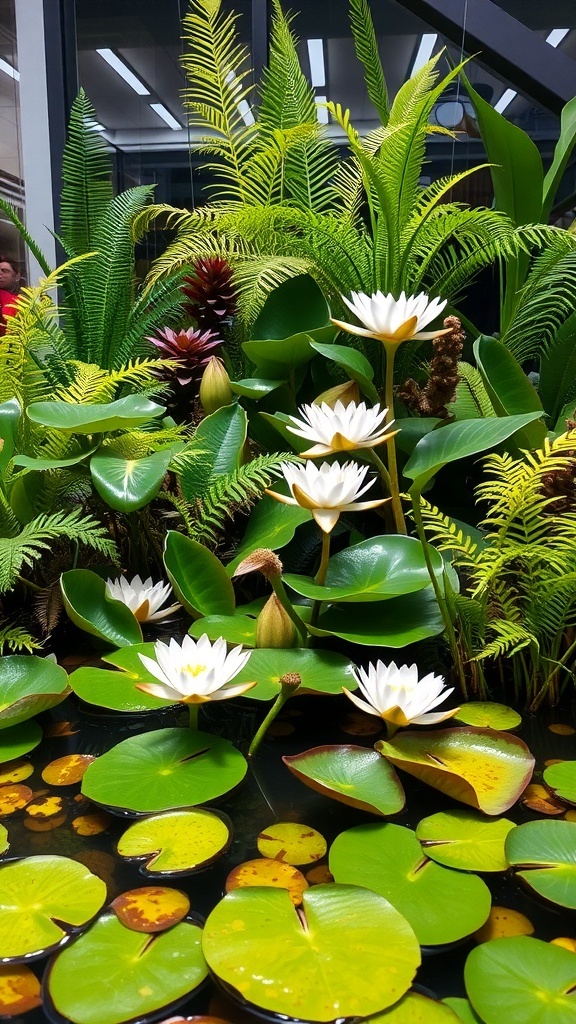
Creating an indoor water garden can be a delightful way to bring nature into your home. The image shows a vibrant collection of aquatic plants, including beautiful water lilies and lush ferns. These plants not only add beauty but also help maintain a healthy ecosystem in your water garden.
When choosing aquatic plants, think about the size of your space. Larger plants like water lilies can serve as focal points, while smaller varieties can fill in gaps. Consider mixing different types of plants to create layers and depth. Floating plants, submerged plants, and marginal plants all have unique roles in the ecosystem.
Water lilies are a popular choice due to their stunning flowers and broad leaves, which provide shade and shelter for fish. Ferns and other leafy plants can add texture and greenery around the edges of your water feature. Make sure to select plants that thrive in the same light conditions as your indoor space.
Don’t forget about maintenance! Regularly check your plants for any signs of disease or decay. Keeping your water clean and balanced will help your aquatic plants flourish. With the right selection, your indoor water garden can be a peaceful retreat that brightens your day.
Maintaining Proper Temperature for Aquatic Life
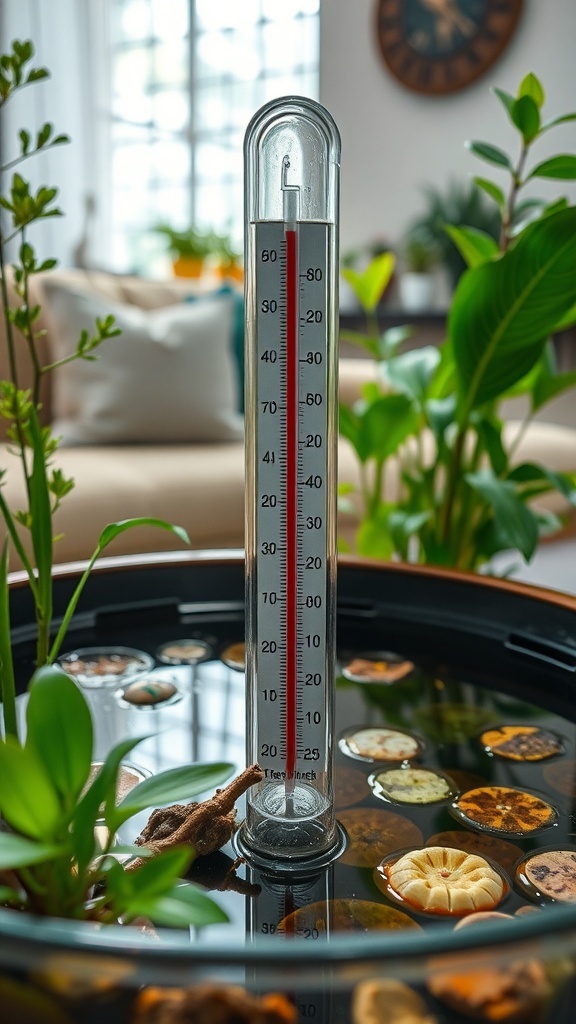
Keeping the right temperature is key for your indoor water garden. The image shows a thermometer placed in a water feature, surrounded by plants and decorative elements. This setup not only looks great but also helps maintain a healthy environment for aquatic life.
Most aquatic plants and animals thrive within a specific temperature range. For many species, this is usually between 70°F and 80°F. If the water gets too cold or too hot, it can stress the plants and fish, leading to health issues.
Regularly checking the thermometer is a simple way to ensure the temperature stays within the ideal range. If you notice the temperature fluctuating, consider adjusting the room temperature or using a heater or cooler designed for aquatic environments.
Also, be mindful of sunlight. Direct sunlight can heat the water too much, while shaded areas might keep it too cool. Finding the right balance is essential for a thriving indoor water garden.
Decorative Elements to Enhance Your Garden
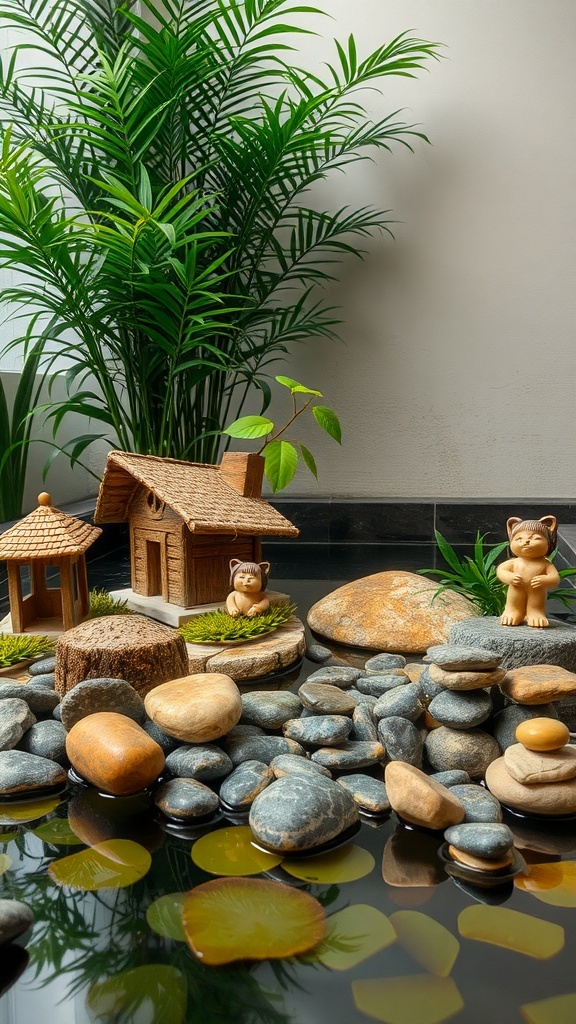
Creating an indoor water garden is a fun way to bring nature inside. The image shows a lovely setup with smooth stones, vibrant plants, and charming little decorations. These elements work together to create a peaceful atmosphere.
In the center, you can see a variety of stones, which add texture and contrast. The different sizes and colors of the pebbles create visual interest. Surrounding the water, they help define the space, making it feel cozy.
The small wooden structures add a whimsical touch. They can resemble tiny houses or garden sheds, inviting imagination. These decorations can also serve as focal points, drawing the eye and sparking curiosity.
Green plants play a vital role too. They bring life and freshness to the garden. The tall, leafy plants in the background create a lush backdrop, enhancing the overall look. They also help purify the air, making your indoor space healthier.
Lastly, the playful figurines add a sense of joy. They can be anything from cute animals to mythical creatures. These little details make the garden feel personal and unique, reflecting your style.
Seasonal Care Tips for Indoor Water Gardens

Indoor water gardens can bring a refreshing touch to your home. They create a serene atmosphere and can be a great hobby. The image shows a lovely water garden with vibrant green plants and a beautiful flower, all illuminated by a stylish light fixture. This setup is perfect for any indoor space.
As seasons change, so do the needs of your water garden. In spring, focus on planting and adding new aquatic plants. This is the time for growth, so ensure your plants have enough light and nutrients. Summer brings warmth, which means you should monitor water levels and temperature closely.
When fall arrives, it’s time to prepare for cooler weather. Trim any dead leaves and consider moving sensitive plants to a warmer spot. Winter requires even more attention. Keep the water temperature stable and reduce feeding, as many plants slow down their growth during this time.
Regular maintenance is key. Clean the water and check for algae buildup. A well-cared-for water garden can thrive year-round, adding beauty and tranquility to your living space.
DIY Water Features for Added Interest
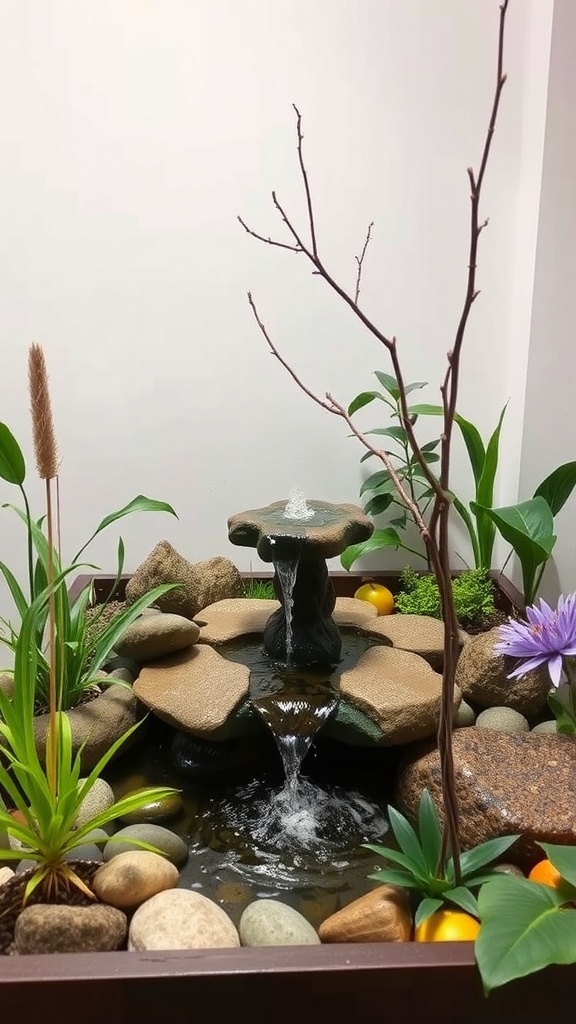
Creating a DIY water feature can bring a refreshing touch to your indoor space. The image shows a charming water garden with a small fountain at its center. This setup combines natural elements like stones and plants, making it a delightful focal point.
The fountain gently spills water, creating a soothing sound that can enhance relaxation. Surrounding it are various plants, adding greenery and life to the scene. The mix of textures from the stones and the smooth surface of the water creates visual interest.
To make your own indoor water garden, start with a container that fits your space. Add a small fountain kit, some pebbles, and a selection of indoor plants. This project is simple and can be customized to match your style. Enjoy the tranquility that a water feature can bring to your home!
Using Natural Filtration Methods
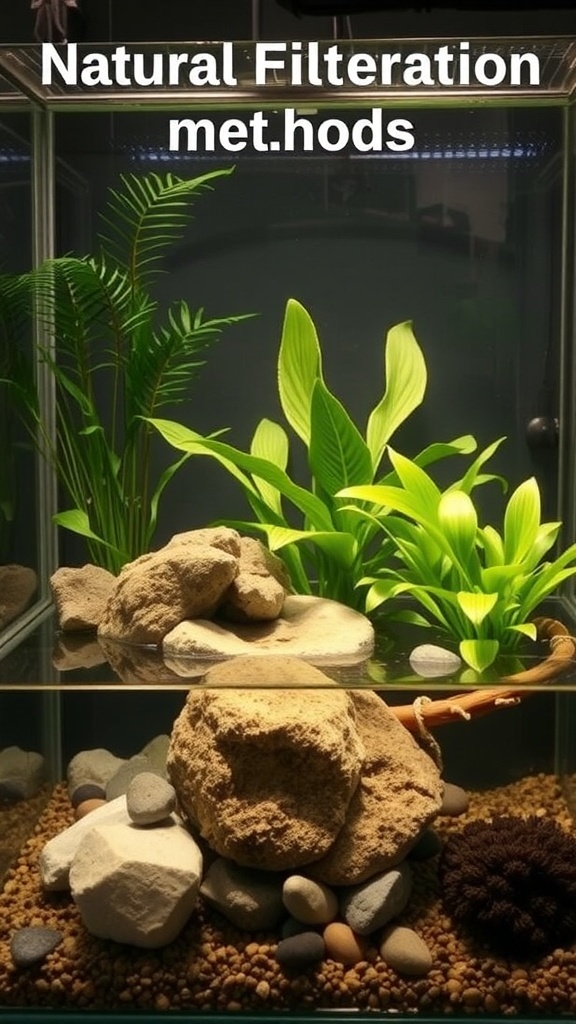
Creating an indoor water garden can be a fun and rewarding project. One of the key aspects to consider is how to keep the water clean and clear. Natural filtration methods are a fantastic way to achieve this.
The image shows a beautifully arranged tank with rocks and plants. These elements play a crucial role in maintaining water quality. The rocks provide a surface for beneficial bacteria to grow, which helps break down waste in the water.
Plants, like those seen in the image, are not just for decoration. They absorb nutrients from the water, which reduces algae growth. This natural balance creates a healthier environment for any fish or aquatic life you may want to include.
Using these natural methods can save you from the hassle of mechanical filters. Plus, it adds a more organic feel to your indoor garden. Regularly checking the water levels and the health of your plants will keep everything thriving.
Choosing the Right Location for Your Water Garden
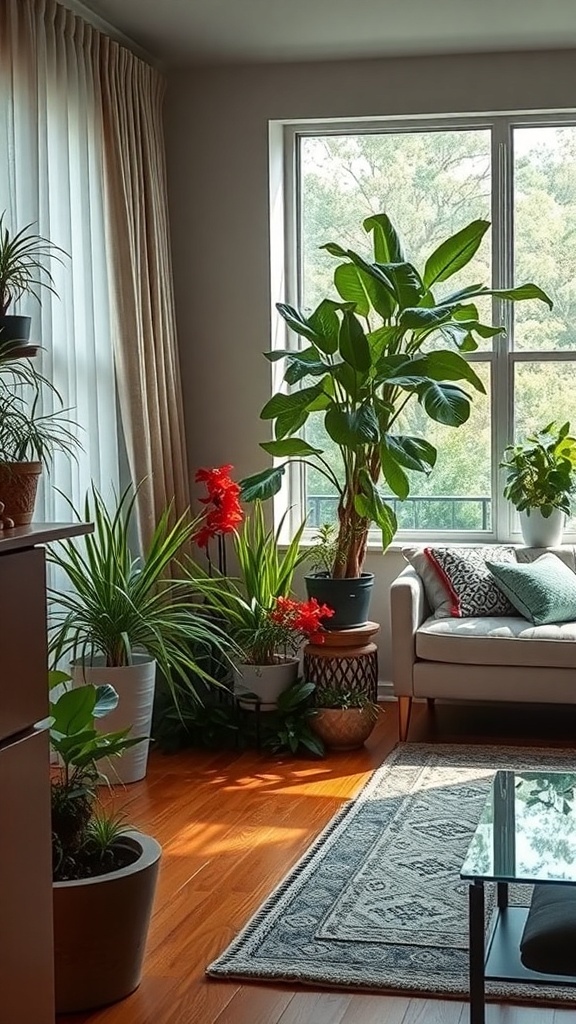
When setting up an indoor water garden, location is key. The image shows a cozy living space filled with vibrant plants and natural light. This kind of environment can inspire you to create a similar oasis in your home.
Look for a spot that gets plenty of sunlight. Plants thrive with natural light, and so will your water garden. A window with a view, like the one in the image, can be perfect. It not only brightens the space but also allows you to enjoy the beauty of your garden.
Consider the size of your water garden. A small tabletop fountain can fit nicely on a side table or shelf. Larger setups might need more floor space. Make sure the area is accessible for maintenance and cleaning.
Lastly, think about the overall vibe of the room. Your water garden should complement your decor. The plants and colors in the image suggest a warm and inviting atmosphere. Choose a location that enhances this feeling, making your indoor water garden a delightful focal point.
Creating a Zen Atmosphere with Your Water Garden
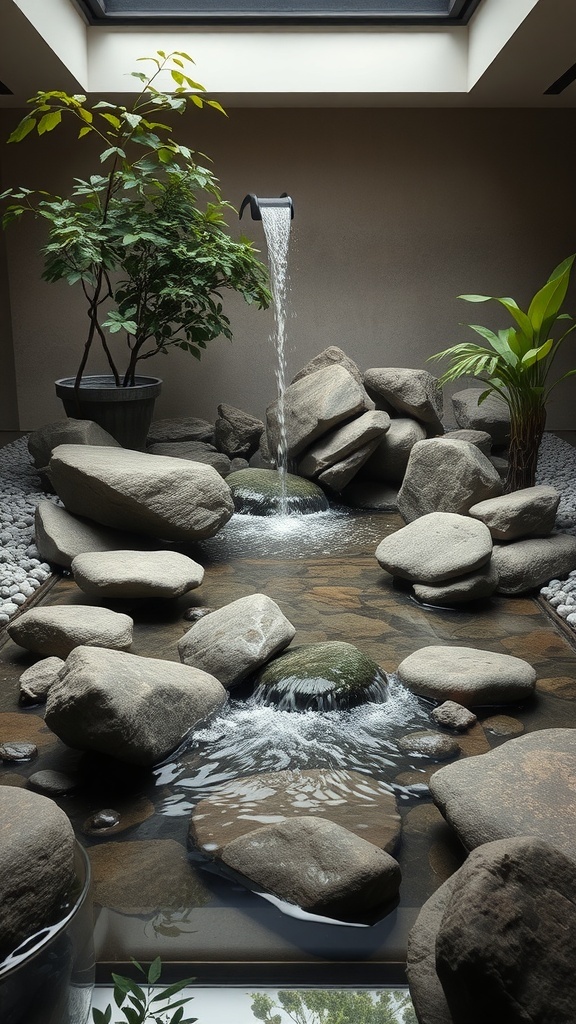
Imagine stepping into a space where the sound of flowing water calms your mind. The image of a serene indoor water garden captures this perfectly. With smooth stones, gentle water flow, and lush greenery, it creates a peaceful retreat right at home.
The water feature, with its sleek design, adds a modern touch while maintaining a natural feel. The plants, thriving in their pots, bring life and color to the space. They not only enhance the visual appeal but also contribute to a fresh atmosphere.
Arranging stones around the water helps create a natural landscape. The way they form a gentle slope invites the eye to explore. This setup encourages relaxation and mindfulness, making it a perfect spot for meditation or simply enjoying a moment of peace.
Lighting plays a key role too. Natural light streaming in from above highlights the water’s movement, creating a soft glow. This enhances the tranquil vibe, making it an ideal environment for unwinding after a long day.
Incorporating an indoor water garden can truly transform your space. It’s not just about aesthetics; it’s about creating a sanctuary where you can escape the chaos of daily life. So, why not bring a bit of nature indoors?
Pest Control Strategies for Indoor Aquatic Plants
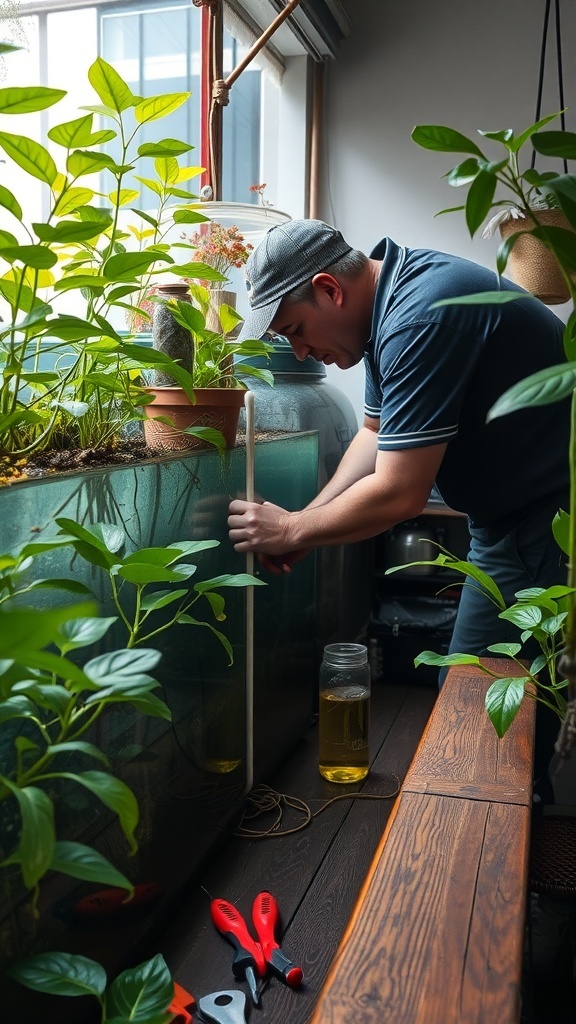
Indoor water gardens can be a beautiful addition to your home, but they can also attract unwanted pests. The image shows a person tending to an aquatic setup, surrounded by lush greenery. This scene highlights the importance of maintaining a healthy environment for your plants.
To keep pests at bay, start by regularly inspecting your plants. Look for signs of infestation, such as discolored leaves or tiny bugs. Early detection is key to preventing a larger problem.
Another effective strategy is to introduce beneficial insects, like ladybugs, which can help control pest populations naturally. You can also use insecticidal soap or neem oil as a gentle treatment for any pests you find.
Maintaining good water quality is essential. Clean water helps your plants thrive and reduces the chances of pests. Regularly change the water and clean any algae buildup. This not only keeps your plants healthy but also discourages pests from making a home in your water garden.
Lastly, ensure your indoor garden has proper air circulation. Stagnant air can create a perfect environment for pests. Use fans or open windows to keep the air flowing. A little attention goes a long way in keeping your indoor water garden pest-free!
Combining Hydroponics with Water Gardening
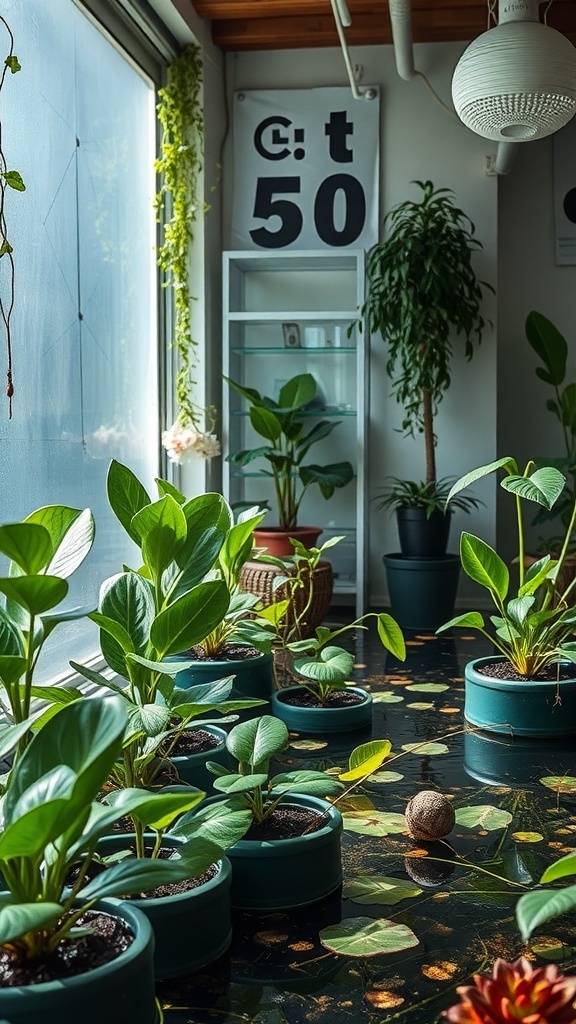
Indoor water gardens are a fantastic way to bring nature inside. The image shows a cozy space filled with lush green plants, all thriving in pots. This setup beautifully merges hydroponics with traditional water gardening.
Hydroponics allows plants to grow without soil, using nutrient-rich water instead. This method is perfect for indoor gardening, as it takes up less space and can be easier to manage. In the image, you can see various plants in pots, each benefiting from this innovative approach.
The water surface reflects the plants, creating a serene atmosphere. This not only looks great but also helps maintain humidity levels, which is beneficial for plant growth. The combination of different plant types adds texture and visual interest, making the space feel alive.
Setting up your own indoor water garden can be simple. Start with a few pots, some quality potting mix, and select plants that thrive in water. You can even add decorative stones or floating elements for extra charm. This blend of hydroponics and water gardening can transform any indoor area into a refreshing retreat.
Monitoring and Managing Algae Growth

Indoor water gardens can be a beautiful addition to your home, but they come with their own set of challenges. One common issue is algae growth. In the image, you can see a hand using a tool to manage the algae on the water’s surface. This is an important step in keeping your water garden healthy.
Algae thrive in warm, nutrient-rich water. To keep it in check, regular monitoring is key. Check the water quality often. Look for signs of excessive algae, like a greenish tint or a thick layer on the surface.
Using tools like the one in the image can help you remove algae effectively. Gently skim the surface to clear away any unwanted growth. This not only improves the appearance of your garden but also helps maintain a balanced ecosystem.
Another tip is to control the amount of light your water garden receives. Too much sunlight can encourage algae to flourish. Consider placing your garden in a spot with indirect light or using floating plants to provide shade.
Lastly, keep an eye on the nutrients in the water. Overfeeding fish or using too many fertilizers can lead to algae blooms. Regular water changes can help keep nutrient levels balanced. With these simple steps, you can enjoy a thriving indoor water garden without the hassle of algae.
Educating Yourself on Aquatic Ecosystems
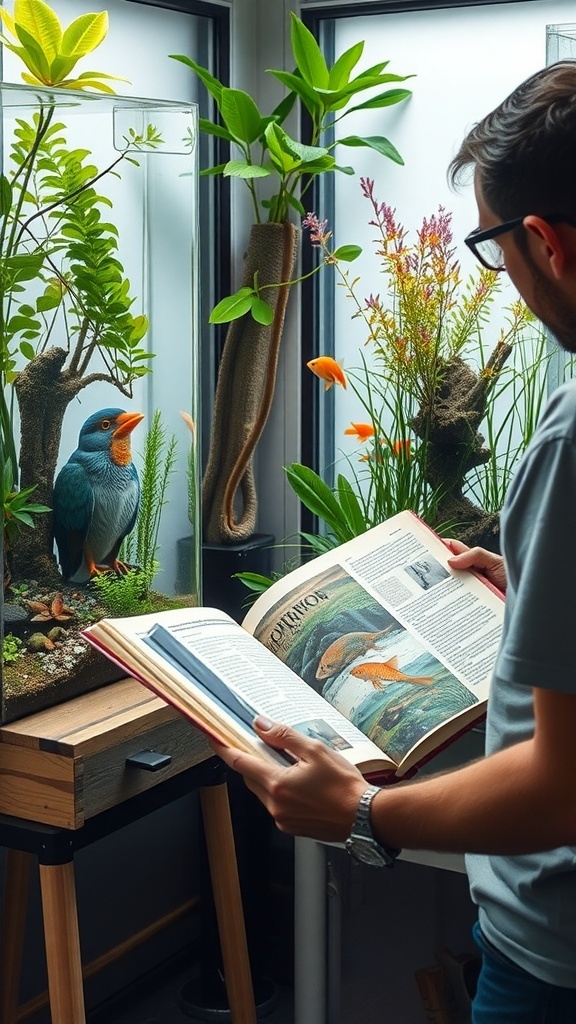
Indoor water gardens are a fantastic way to learn about aquatic ecosystems. The image shows a person reading a book while observing a vibrant aquarium filled with plants and fish. This setup creates a small ecosystem that can teach us so much about nature.
As you look at the plants and fish, you can see how they interact. The plants provide oxygen and shelter for the fish, while the fish help with nutrient cycling. This balance is key to maintaining a healthy ecosystem.
Reading about aquatic life can deepen your understanding of these interactions. The book in the image likely covers various species, their habitats, and the importance of biodiversity. Knowledge gained from such resources can inspire you to create your own indoor water garden.
Setting up an indoor water garden is not just about aesthetics; it’s a hands-on way to engage with nature. You can experiment with different plants and fish, observing how they thrive together. This experience can spark curiosity and a desire to learn more about the environment.
